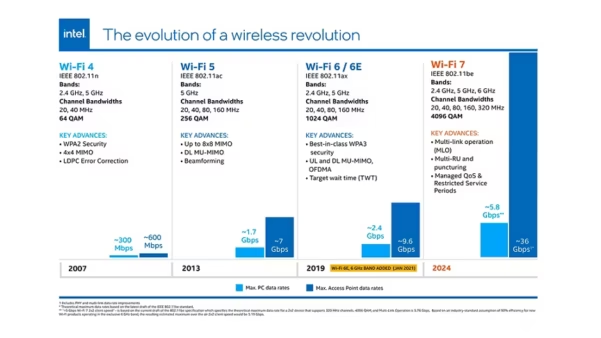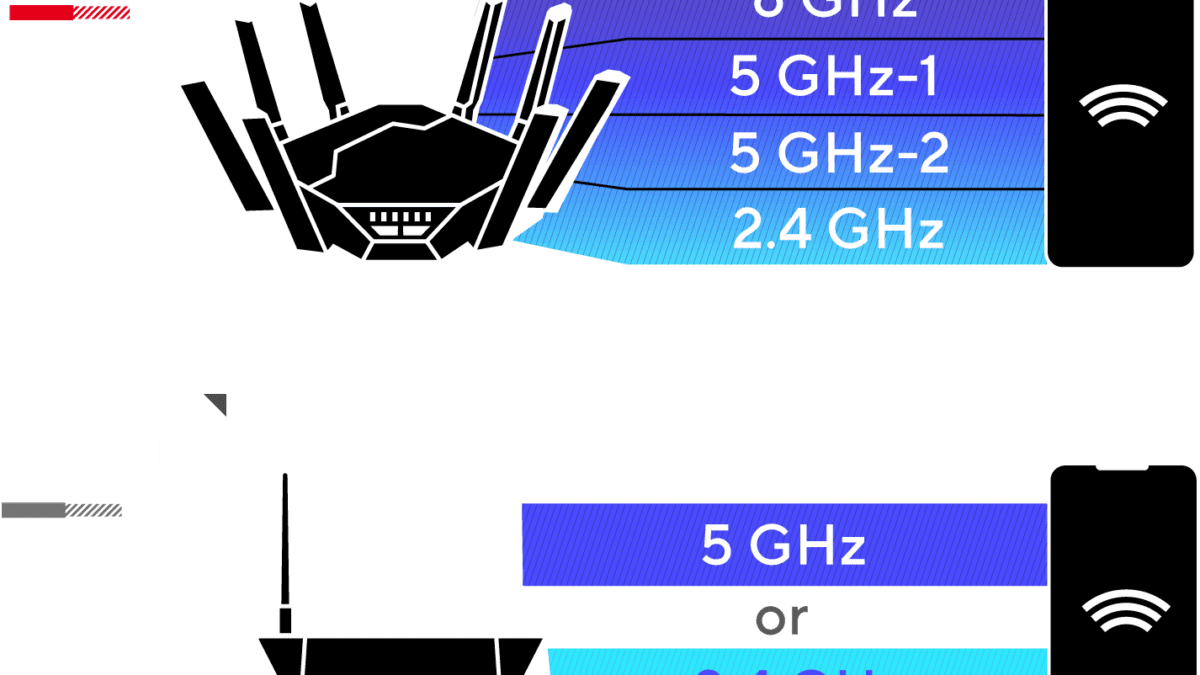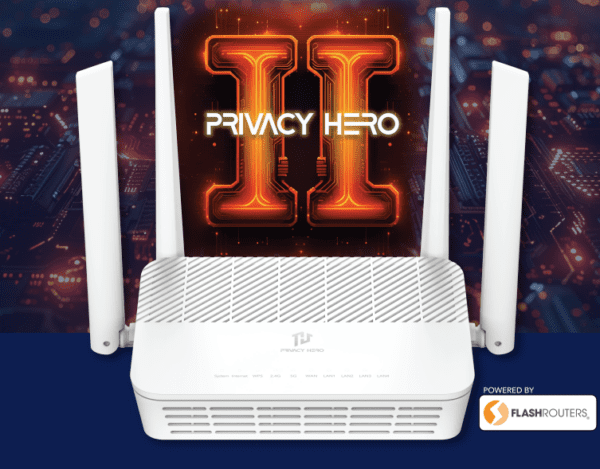Is WiFi 7 Worth It? Comparing Early Wi-Fi 7 Adoption Benefits, Network Throughput & More.
Early Adopter Advantages: Why Getting Wi-Fi 7 Now Makes Sense
 Welcome to the third part of our Wi-Fi 7 series! If you missed our previous posts, check out Part 1: Wi-Fi 7 Explained and Part 2: Game-Changing Features to get caught up.
Welcome to the third part of our Wi-Fi 7 series! If you missed our previous posts, check out Part 1: Wi-Fi 7 Explained and Part 2: Game-Changing Features to get caught up.
Today, we’re tackling the big question on many people’s minds: “Should I buy Wi-Fi 7 now, or wait until prices drop and more devices support it?”
While there’s no one-size-fits-all answer, there are some compelling reasons why being an early adopter might pay off in both the short and long term. Let’s dive in to the full advantages of being an early adopter!
The “Early Adopter Tax” vs. Immediate Benefits
Yes, Wi-Fi 7 routers cost more than Wi-Fi 6 models right now – that’s the “early adopter tax” we all pay for cutting-edge wireless technology. But here’s the thing: the benefits start immediately, even while you’re waiting for more Wi-Fi 7 client devices to hit the market.
How? Because even your existing devices can take full advantage of:
- Better processor performance in newer routers
- More advanced antennas and signal processing
- Improved handling of network congestion
- Enhanced security features
- Better coverage from upgraded hardware
One of our customers recently upgraded from a high-end Wi-Fi 6 router to our ASUS GT-BE98 Pro and reported that even their older devices were connecting more reliably and experiencing fewer dropouts – an immediate benefit before adding any Wi-Fi 7 clients.
Is Wi-Fi 7 worth the investment for early adopters?
As technology evolves, the question arises: Is Wi-Fi 7 worth the investment?
For those who adopt new technology quickly, putting money into Wi-Fi 7 can yield prompt advantages, especially if they depend significantly on their network setup for tasks such as working from home, streaming, and gaming.
With its promise of significantly improved performance, understanding the benefits, throughput, and implications of early adoption is essential.
The Cost-Over-Time Perspective
While Wi-Fi 7 routers are more expensive now, consider the cost spread over the device’s useful life. If you keep a router for 4 years (the average for our customers), the price premium of Wi-Fi 7 breaks down to:
- $200 premium ÷ 48 months = $4.17 per month
- $4.17 per month ÷ 30 days = $0.14 per day
When you look at it this way, you’re paying just a few dollars per month for significant performance improvements and future-proofing. For many homes and certainly most businesses, that’s a very reasonable investment in Wi-Fi 7 technology.
 Staying Ahead of the Bandwidth Curve
Staying Ahead of the Bandwidth Curve
Internet usage doesn’t stay flat – it grows exponentially. Think about how your household bandwidth needs have changed over the past 3-5 years with the rise of wireless devices and smart home technology:
- Video calls became everyday occurrences
- Streaming services moved from HD to 4K
- Cloud gaming services gained popularity
- Smart home devices multiplied
- Remote work became permanent for many
Now imagine how your needs will evolve over the next 3-5 years (the typical lifespan of a router). Will 8K streaming, augmented reality, or virtual reality become common in your home? Will you add more smart home devices? Will your work-from-home setup need even more reliable connectivity?
Early Wi-Fi 7 adopters are essentially future-proofing their networks for these emerging needs. It’s like buying a bigger house than you currently need because you’re planning to grow your family.
Work From Home Like a Pro
If you’re working remotely, your home network is now business-critical infrastructure. Wi-Fi issues don’t just mean buffering Netflix anymore – they mean dropped client calls, missed deadlines, and professional frustration.
Wi-Fi 7’s multi-link operation creates a more office-like experience by:
- Maintaining stable video calls even when family members start streaming
- Keeping your connection reliable throughout the day
- Reducing latency for better real-time collaboration
- Supporting multiple simultaneous high-bandwidth applications
Several of our work-from-home customers report 15-20% productivity improvements just from eliminating those annoying connection hiccups during important meetings, thanks to better Wi-Fi reliability. When you calculate the value of your time, Wi-Fi 7 can quickly pay for itself in a professional context.
Beat Your Competition
For businesses, being an early Wi-Fi 7 adopter can create meaningful competitive advantages in terms of faster speeds, lower latency, and improved throughput.
For Retail and Hospitality
If you run a cafe, hotel, store, or restaurant, having super-fast, reliable Wi-Fi gives you an edge. Your customers will notice the difference when streaming, shopping online, or using bandwidth-heavy apps in your space, especially with Wi-Fi 7. Several of our cafe customers have reported increased customer dwell time after upgrading to Wi-Fi 7.
For Small Offices
Being the first in your industry to implement Wi-Fi 7 can improve client meetings, speed up file transfers, and create a more seamless collaborative environment. One architectural firm told us their client presentations became much more impressive after they could wirelessly stream high-resolution renderings without any hiccups.
For Tech-Forward Homes
Even in residential settings, having the best Wi-Fi on the block has its advantages. Hosting game nights, movie streaming, or simply accommodating all your kids’ friends and their devices becomes much easier with Wi-Fi 7’s expanded capabilities.
When Waiting Might Make Sense
Despite all these advantages, waiting might still be the right choice if:
- Your current router works perfectly for your needs
- You have no performance complaints with your existing setup
- Your internet connection is slower than 500 Mbps (you won’t see the full benefit)
- You’re on a very tight budget
- You have no immediate plans to adopt bandwidth-intensive technologies
There’s no shame in waiting if Wi-Fi 7 doesn’t solve an immediate problem for you. Technology prices do tend to decrease over time, and more client devices will support it in the future.
 Master the Technology Early
Master the Technology Early
Early adopters gain valuable experience with new Wi-Fi technology before it becomes mainstream, especially in utilizing 6 GHz bands. This creates an expertise advantage that can be valuable in several ways:
- You’ll be the go-to expert when friends, family, or colleagues start their Wi-Fi 7 journey later
- You’ll develop optimization strategies others haven’t discovered yet
- You’ll better understand which features matter most for your specific needs
- You’ll be ready to take advantage of new Wi-Fi 7 client devices the moment they’re available
This experiential knowledge is particularly valuable for IT professionals, tech enthusiasts, and anyone who serves as the default “tech support” for their social circle.
How does Wi-Fi 7 compare to Wi-Fi 6?
Wi-Fi 7 is designed to be significantly faster than Wi-Fi 6 or WiFi 6e, with potential maximum throughput reaching up to 46 Gbps compared to Wi-Fi 6’s 9.6 Gbps. T
his improvement in bandwidth is made possible through advanced modulation techniques and the use of the 6 GHz band, which reduces congestion that typically affects WiFi networks operating on the 2.4 GHz and 5 GHz bands.
Through advanced modulation techniques and wider channel bandwidths, which can reach up to 320 MHz, Wi-Fi 7 can handle more data at once, resulting in faster speeds and a more reliable network experience for users. In practical terms, this translates into smoother streaming, quicker downloads, and a better overall performance for applications demanding high data rates.
What types of client devices will support Wi-Fi 7?
Wi-Fi 7 will be supported by a range of client devices including smartphones, laptops, and smart home devices. However, to take full advantage of Wi-Fi 7, these devices will need to be equipped with Wi-Fi 7 chipsets. The rollout of Wi-Fi 7 devices is expected to accelerate as we approach the anticipated adoption in 2025.
What about expected latency with Wi-Fi 7?
One of the key features of Wi-Fi 7 is its promise of lower latency. The enhancements in the protocol allow for quicker response times, which is particularly beneficial for applications like online gaming and video conferencing. With Wi-Fi 7, users can expect a more seamless experience without the lag that often accompanies older Wi-Fi standards. This aspect is crucial for environments where timing is critical, such as in professional settings or competitive gaming.
What’s Next?
In our next and final post in this series, we’ll compare the top Wi-Fi 7 routers available from FlashRouters and help you choose the perfect model for your specific use case. We’ll break down the differences between the ASUS, Netgear, and other models to make your decision easier.
Ready to Experience Wi-Fi 7?
If you’ve decided that now is the right time to upgrade, check out our selection of Wi-Fi 7-compatible routers. Each one comes with our enhanced FlashRouters firmware for better security, VPN support, and optimized performance, ensuring minimal interference with your day-to-day activities online.
Still have questions about whether Wi-Fi 7 is right for your specific situation? Our tech experts are always happy to provide personalized advice. Just reach out to our support tea/m, m, and we’ll help you make the right decision for your needs and budget.
Stay tuned for our final post where we’ll compare the top Wi-Fi 7 routers head-to-head!






